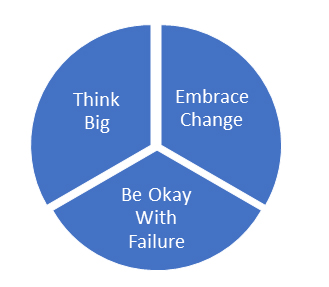
Hear from Lisa Dorian at her upcoming seminars:
- Setting the Tone: It Only Starts at the Top, Oct. 21, 2020
- Developing Meaningful KPIs, Oct. 30, 2020
We live in a world where the speed of change is more rapid than ever before. New technologies have disrupted many industries, shortening or ending their life cycles, while at the same time creating new industries. We need look no further than Netflix and Blockbuster Video for a lesson in industry disruption. Where Netflix saw what was possible and decided to pursue an emerging technology, Blockbuster Video refused to adapt, leading to its demise and disappearance almost overnight.
Clearly, for an organization to survive rapid change, the need to harness people’s potential for creativity and innovation has never been more critical. To put it in perspective, a recent report from the World Economic Forum noted that the three most important leadership qualities by 2020 will be complex problem solving, critical thinking, and creativity.
However, to be a creative leader does not mean you need to be creative. What it does mean is that you need to understand the creative process to help facilitate creative thinking. It means applying an entrepreneurial mindset, regardless of the size or type of organization you work in.
The entrepreneurial mindset can be defined as focusing on three things: embracing change, being okay with failure, and thinking big. Let’s explore what each of these means and how you can apply them.

Embrace change
Nuclear physics pioneer William Pollard said, “Without change there is no innovation, creativity, or incentive for improvement.” Being open to change means that where there is a problem to be solved, you involve a diverse group of people to address it. By bringing diversity to the problem, different perspectives and new ideas will emerge.
Be supportive of these different perspectives and allow for healthy debate. In doing so, you allow the creative process to flow, which creates opportunities for new approaches and solutions to emerge. These solutions could push your organization to be leading-edge and extend its life cycle. Or, these solutions could just as easily fail. And then you will need to start over. Is that a bad thing? Absolutely not. In fact, the most innovative companies are the ones that fail fast and often.
Chip and Dan Heath wrote in their book Switch: how to change things when change is hard that “[P]eople who change have clear direction, ample motivation, and a supportive environment.” The advantage of bringing diversity and different perspectives to a problem is that they will help clarify what needs to be changed and why. From a change management perspective, what looks like resistance to change is often simply a lack of clarity.
Further, when a group of people is tasked at looking at a problem to be solved, they are often more likely to buy into the solution as they will be the ones who develop it. This then provides them the motivation to see the change through. The last component to embracing change is the supportive environment. What may be seen as a people problem is usually just a situational problem. Therefore, when people are working through the solution, it will be important to ensure they have the right tools and that they are encouraged throughout the process.
Be okay with failure
Being okay with failure is about encouraging risk taking and accepting that failure can happen. As Albert Einstein said, “Failure is success in progress.” Baba Shiv, a professor at the Stanford Graduate School of Business whose research focuses on innovation in the workplace noted, “If you’re trying to solve a problem there are potentially hundreds of possible pathways to take, but only a few are going to lead to the appropriate solution. And the only way to discover that is to try and fail and try again.”
Failure can be a scary thing for a leader, but by encouraging new ideas, it is a fact of life. It’s how the failure is handled that will dictate whether the organization will be pushed forward. When failure occurs, it needs to be analyzed. What you learn from a failure can then be used to try a different approach. One that will eventually lead to success.
How can your company mine for opportunities from previous failures? One way is to set up a reporting protocol so that people are comfortable talking about their failures. In fact, they can be encouraged to do so. This helps others in the organization know what projects may be ongoing and they may find synergies with their own projects.
Creating a database of projects, both successful and unsuccessful, with a post-mortem analysis of each can also help organizations learn from both successful and failed projects and find key take-aways that can be applied in the future, or find areas that may be revisited in the future, depending on the reason for the failure.
Think big
And that brings us to our final component of the entrepreneurial mindset…THINK BIG! Masayoshi Son, founder and CEO of SoftBank said, “Think big; think disruptive. Execute with full passion.” Why did he say this? Because he knew that in order to be innovative, you need to think big. To take risks. To be open to possibility. And to see the future in a different way.
It means taking a deep-dive approach. How can you redefine the experience of your stakeholders, based on new trends that you are seeing? Who are likely to be your competitors five years from now? How will they differ from who they are now? Ultimately, thinking big captures embracing change and being okay with failure. Having a diverse team that is allowed to brainstorm and be creative. And then allowing that creativity to push forward new ideas to try.
I’ll leave you with this one last quote, again from William Pollard: “Learning and innovation go hand in hand. The arrogance of success is to think that what you did yesterday will be sufficient for tomorrow.
Lisa Dorian, CPA, CA, CPA (IL), CRMA, is managing director of Learning Strategies Group’s US operations. She has designed, developed and delivered numerous training programs for organizations globally.



